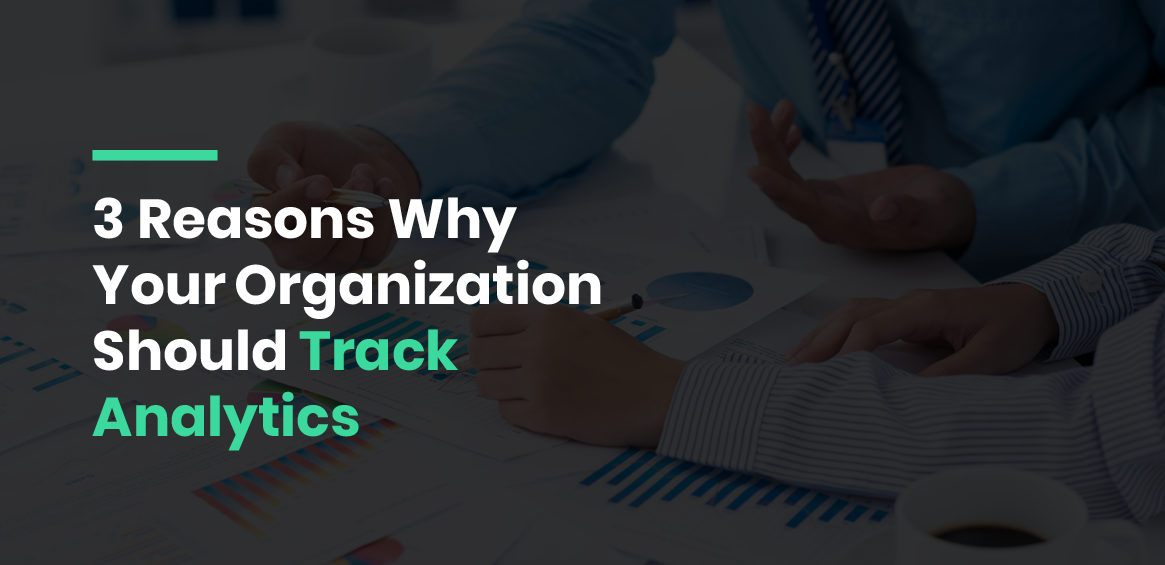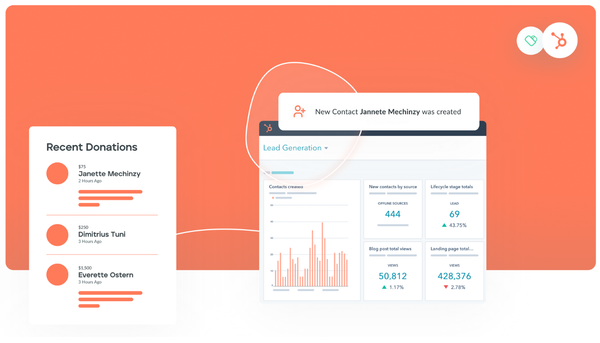3 Reasons Why Your Organization Should Track Analytics
Tracking analytics allows your nonprofit to determine the best course of future action. Here are four reasons why your organization should track analytics.

Never before have nonprofits had greater access to supporter information and technology for tracking data. Gone are the days of taking wild guesses and making assumptions about what your next move should be or how you should design your next fundraising campaign.
Data analytics take the guesswork out of marketing and fundraising, leaving you with measurable, actionable insights to drive your campaigns.
Your organization likely gathers data all the time, from supporter information to website metrics and budget information. Data analytics is the process of assessing this data in the context of your organization’s goals.
Here are three reasons why your organization should track data analytics:
- Measure your marketing ROI.
- Improve your donor engagement efforts.
- Ensure transparency and regulatory compliance.
Before you launch into the data analytics process, ensure that your organization has proper nonprofit data management strategies in place for storing your insights. A robust constituent relationship management (CRM) platform will provide the framework your organization needs to track information. Comprehensive database management procedures will ensure that your team is empowered to maintain the cleanliness and effectiveness of your database.
With that, let’s get started.
1. Measure your marketing ROI.
Marketing is an effective way to reach new audiences, but it comes with a cost. Your marketing investment should pay for itself when your organization reaches its goals of engaging new audience members.
Data analytics can help you assess the state of your marketing campaigns and if you’re achieving a high return on investment (ROI). You can calculate your marketing ROI by dividing the total revenue generated from your marketing efforts by the cost of carrying out those marketing efforts.
Assess your marketing ROI to determine if your current marketing approach is successful. If you find the ROI is less than you were hoping, adjust your strategy to determine which type of campaigns are most effective moving forward.
2. Improve your donor engagement efforts.
To grow your fundraising, your nonprofit expends specific efforts to engage both prospective and current donors.
Assess donor engagement analytics to understand the successes and challenges of your donor engagement campaigns. Then, you can adjust your strategy to ensure that you’re directing your outreach efforts toward those who are most likely to respond.
Analyze metrics such as email open rates, social media engagement rates, and donor demographics to determine how supporters prefer to engage with your organization. Then, you can group supporters based on shared characteristics and preferences.
For example, let’s say you discover you have a large group of supporters who open your emails every time. You can create a segment of these supporters using your email marketing platform to continue sending email communications to them. You may also discover another group of supporters who open your emails occasionally, about once a month. You can limit the number of emails you send to these individuals to align with their preferences for less frequent communication.
Dataro's fundraising analytics guide recommends using your donor metrics to conduct RFM segmentation — organizing donors by recency, frequency, and monetary value. For instance, you might create segments for donors who gave within the past month (recency), those who contribute once a year (frequency), and those who donate between $50-$200 each time they give (monetary value). Then, you can send relevant information to each group, like year-end giving appeals to your annual donors or thank-you letters to your recent donors.
Data analytics allow you to narrow your focus and send donors communications that are more likely to resonate with them. This can lead to greater supporter satisfaction and retention.
3. Ensure transparency and regulatory compliance.
Nonprofits are in the unique position of having a variety of stakeholders who require access to information about their financial situation:
- Prospects and donors want to know if their gifts are being used wisely to help further your cause.
- Grantors want to know if your organization is financially sound and has a plan for using the funding that they provide.
- The government requires access to your financial information so your organization can maintain its tax-exempt status.
- Local community members are interested in whether your organization is providing a service or support to their community.
Tracking financial analytics allows you to maintain accurate records of your organization’s financial history and health. By tracking budgeting, revenue, and the costs of daily operations, you ensure that you’ve got this information at the ready if any interested parties come knocking on your door.
Also, tracking financial analytics gives your organization a structured way to assess your progress year after year and build on your successes. You can analyze trends during successful and challenging years to understand what led to each situation.
After reviewing these reasons to track analytics, you might be thinking of how this practice can benefit your organization. If you’re ready to get started with data analytics, read on to understand the four types of metrics your organization should focus on.
Bonus: 4 Types of Analytics Your Organization Should Track
There are plenty of data points that arise throughout your daily nonprofit operations. You might feel overwhelmed by the sheer amount of information your organization processes daily.
Luckily, DNL OmniMedia's nonprofit analytics guide pinpoints the four essential types of data analytics your team should focus on:
1. Web Analytics
Web analytics let you know how successful your nonprofit’s website is at engaging visitors and driving donations. You can use website analytics to determine the best way to adjust your website design to drive more conversions.
Before you make any changes to your site, it’s helpful to review metrics such as:
- Site traffic sources: This covers how users reach your website, whether through search engine results, finding a link on other websites, or clicking on your site via social media. You can boost your website visits by pursuing a variety of paid and organic digital marketing campaigns, such as Google Ads or search engine optimization strategies.
- Average website visit duration: This is how long users spend on your website before clicking away. If visitors are clicking on your site but immediately bouncing off, you should adjust your website design or content to make it more appealing and engaging. Think of what website visitors want to find when they visit your site, and design it in a way that they can find this information immediately.
- Website conversion rate: This refers to how successful your site is for converting visitors into supporters. This can be determined through setting up measurements for how many users take a desired action on your site, such as submitting a donation, registering for a volunteer opportunity, or signing up for your newsletter. You can also boost this metric by improving your website design and your calls to action.
Your website is one of your organization’s most visible marketing tools, so ensure it’s optimized to engage both prospective and current supporters. Consider what would be appealing for both audiences, whether it’s detailed information about your nonprofit for prospective supporters to review, or an upcoming event calendar for current supporters to know what’s on the horizon.
2. Email Marketing Analytics
Email remains an incredibly vital and effective marketing channel for nonprofits. Email marketing analytics can reveal the relative success or failure of your email campaigns.
Depending on your email platform, you might have access to analytics such as:
- Open rate: How many people open your email messages? If you’re seeing low open rates, you might focus on improving your email subject lines by making them more enticing and relevant to your mission.
- Click-through rate (CTR): How many people open your emails and click on the links within your messages? People can’t take any action within your email itself ─ they have to click through to view your online donation page, volunteer registration form, or other website pages you’re promoting. The CTR tells you how many people took the next step and engaged further with your organization.
- Conversion rate: How many people took the desired action promoted in your emails? This metric illuminates your ability to entice supporters to fully engage with your organization. This might be the number of people who donated, signed up to volunteer, registered for an event, or advocated for your cause online.
When they’re well-designed, your email campaigns can lead audience members through the process of becoming more deeply engaged with your organization. Think about how you can make your email messages more enticing at every turn, whether it’s adding more engaging visual elements or simplifying your design so that it prioritizes the most important information.
3. Fundraising Analytics
As a nonprofit professional, fundraising is one of your top concerns. You can’t grow your organization or make progress toward your mission without strong fundraising support.
There are several fundraising analytics you can store and track using your nonprofit CRM, including:
- Donor retention rate: This is the number of donors who continue to give to your nonprofit. A low donor retention rate might mean your organization needs to do a better job of stewarding donors and building relationships with them after they contribute to your cause. You can implement more donor appreciation efforts, ongoing communication, and convenient giving opportunities to boost your retention.
- Donor demographics: This covers characteristics such as age, occupation/employer, education level, income, and family data such as marital status. Tracking demographics allows you to reach out to donors in ways that resonate with them. Plus, you can identify demographic trends in your database that can help you craft overarching marketing strategies.
The key to better fundraising is learning more about your donors and communicating with them based on all you’ve discovered. Data analytics can provide the background you need to start building strong relationships with supporters.
4. Financial Analytics
The final category of analytics your organization should track is financial data. Even though your organization isn’t driven by profit, you still need to ensure that your finances are healthy so that you can continue staying in operation, paying your staff, and providing your services.
You can assess your financial viability by tracking:
- Revenue: This includes the funds generated from your fundraising initiatives and other funding sources. You must identify all of the sources of your organization’s funding so that you can understand the areas you need to focus on optimizing. You can cut back on other areas or initiatives that aren’t as impactful for your revenue.
- Cost per dollar raised: This is the cost of putting on a fundraising or marketing initiative divided by the amount it brought in. This is an effective metric for illustrating your organization’s ROI. You can assess how effective each event, campaign, or initiative is over the long term.
Maintaining clear financial records allows you to assess your fundraising progress year after year to gain a fuller picture of where your organization stands. In lower revenue periods, you can adjust your donor engagement and outreach efforts to help your organization raise more the next year.
Analytics illuminate insights about your organization that you otherwise might not have noted. Remember to store all data points and insights in your organization’s CRM and establish strong data hygiene procedures for your team to follow. This will allow you to benefit from a backlog of historical data to compare in future campaigns.
Carl Diesing, Managing Director, DNL OmniMedia
Carl co-founded DNL OmniMedia in 2006 and has grown the team to accommodate clients with on-going web development projects. Together DNL OmniMedia has worked with over 100 organizations to assist them with accomplishing their online goals. As Managing Director of DNL OmniMedia, Carl works with nonprofits and their technology to foster fundraising, create awareness, cure disease, and solve social issues. Carl lives in the Hudson Valley with his wife Sarah and their two children Charlie and Evelyn.





